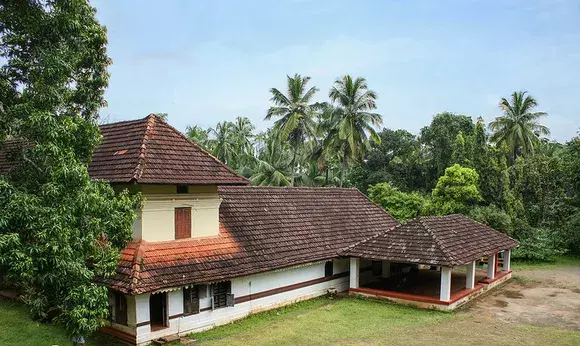Kerala's traditional houses embrace a timeless charm with their sloping roofs and welcoming courtyards. These sustainable homes, known as Nalukettu, are rooted in the principles of Thachu Shastra (the science of carpentry) and Vaastu Shastra, the ancient Indian system of architecture.
Imagine stepping into a world where tradition and sustainability seamlessly blend together. Kerala's Nalukettu houses offer a glimpse into this magical realm. Derived from the words "nalu" meaning four and "kettu" meaning blocks, a Nalukettu is a rectangular structure consisting of four blocks interconnected by an open courtyard. It goes by different names such as Tharavadu, Kovilakam, Kotare, Meda, or Illam, but they all share the same architectural brilliance.
A Sustainable Haven
 Pic: Flickr
Pic: Flickr
Nalukettu homes are not just aesthetically pleasing; they are also eco-friendly and cost-effective. With sloping roofs and terracotta tiles, these houses effectively drain water and maintain cool interiors during humid weather. Kerala's climate and environment provide an ideal canvas for sustaining the Nalukettu architectural style.
Building Blocks of Sustainability
The construction materials used in Nalukettu houses are carefully selected to minimize the carbon footprint. Clay, timber, palm leaves, and stone, all locally sourced, contribute to sustainability while ensuring durability.
Wood, particularly Teakwood, Mahogany, or jackfruit wood, holds a special place in Nalukettu construction. Not only is wood a renewable resource, but for every cubic meter used, it helps save around one tonne of carbon dioxide from being released into the atmosphere. The craftsmanship involved in carving intricate designs into the wooden walls, pillars, and roof showcases the skill of the artisans.
Designing Harmony with Nature
 Pic: Kerala Tourism
Pic: Kerala Tourism
Nalukettu designs incorporate courtyards and verandahs that connect various rooms, providing ample natural lighting and cross-ventilation. The Nadumuttom, an open central courtyard, becomes the heart of the house. It serves as a focal point, allowing sunlight and fresh air to permeate the entire structure.
Alignment with Vaastu Shastra principles plays a significant role in Nalukettu homes. The four blocks symbolize the four directions, with specific functions assigned to each. The temple or puja room finds its place in the eastern block (kizhakkini), while the northern block (vadakkini) is an auspicious spot for the kitchen. The western block (Padinjattini) serves as a storage area for grains, and the southern block (Thekkini) stores wealth and houses the rooms.
Preserving Tradition, Embracing Sustainability
 Pic: Flickr
Pic: Flickr
Nalukettu homes cherish the essence of Kerala's rich culture and heritage. Every aspect, from the arched gateway (Padippura) resembling a temple gopuram to the inner verandahs, showcases a deep-rooted connection with tradition. The wooden seating areas (Charupadi) on the verandahs provide a space for socializing and enjoying nature's beauty.
The pillars, instead of walls, support the roof frame, allowing for better ventilation and protection against dampness. Additionally, the inclusion of a pond at the end of the verandah adds a touch of tranquility and helps balance energies according to Vaastu Shastra principles.
Sustainable Stories Passed Down
Nalukettu houses reflect the pride of Kerala's architectural heritage and serve as a testament to sustainable living. These homes stand as a reminder that embracing eco-friendly practices and preserving cultural traditions go hand in hand.
Kerala's Nalukettu houses are not just buildings; they are living examples of sustainability, aesthetics, and a harmonious coexistence with nature. Let's celebrate and preserve these treasures, passing down their stories to future generations.

















